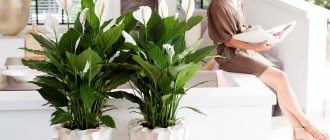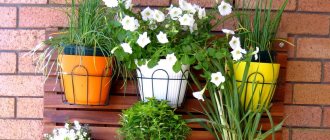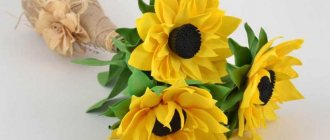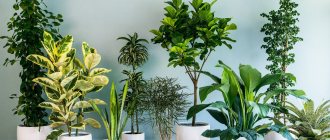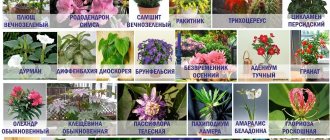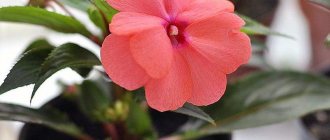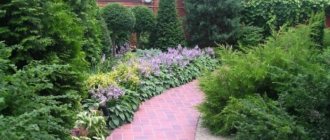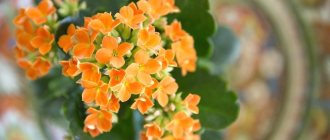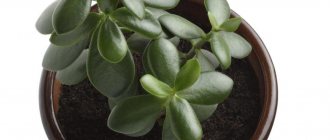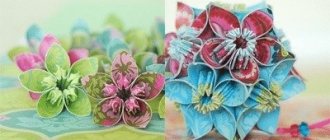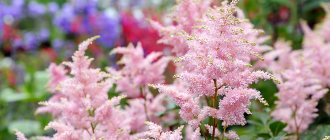Calamondin
A perennial tree of the oral family from East Asia, bred by crossing a kumquat with a mandarin orange. When grown at home, it reaches a height of 60-150 cm. The plant is distinguished by its juicy, dense greenery and bears fruit abundantly.
Calamondin does not tolerate direct sunlight and loves warmth. Feels best at a temperature of 18-20 ºC. In summer, the plant should be watered more abundantly than in winter.
Dracaena fragrant
A tall plant of the Asparagus family, native to Africa. In room conditions it can grow up to two meters. It has a woody trunk and long narrow leaves at the top of the crown and around the trunk.
Prefers moderate lighting at temperatures from 18 to 25 ºC, and is not afraid of shadows. Dracaena is unpretentious in care; it requires regular moderate watering without waterlogging the soil and loosening. Water for watering this plant should be settled.
Monstera photo
Monstera is a beautiful evergreen plant that belongs to the liana family. This is one of the most common indoor plants. Young leaves are whole, with age they become perforated, and then completely split. Monsteras are widespread in Central and South America. The gigantic size of the plant and its bizarre appearance served as the basis for the name of the entire genus (from monstrum - monster, and perhaps “bizarre”).
Latest articles for gardeners, gardeners and flower growers
Pruning cherries in the fall for beginners in pictures step by step
What to plant after tomatoes next year
What to plant after strawberries in the fall
Planting garlic in autumn before winter in Siberia
Monsteras are evergreen plants, vines, and shrubs with thick climbing stems and often hanging aerial roots. The leaves are large and leathery. The petiole is long, vaginal at the base. The inflorescence is a spadix, thick, cylindrical. The flowers at the base of the spadix are sterile, higher up they are bisexual. In general, monsteras are unpretentious and quite easy to grow, and perhaps that is why these evergreen tropical vines with beautifully dissected dark green leathery leaves with slots and holes of various shapes are one of the most common indoor plants. You just need to take into account that even in indoor conditions these plants stretch several meters, so it is better to grow them in cool and spacious offices, foyers and hallways. Can be used for shading (as climbing plants) and for trellises.
Monsteras take root ideally in heated winter gardens. The plant promotes ionization of indoor air.
Dieffenbachia
A popular houseplant of the araceae family, imported from South America, named after a botanist from Germany. Loves light and warmth, but needs protection from the scorching rays of the sun.
The plant has thick stems with large variegated leaves. If the stem is damaged, it releases poisonous juice that can cause a burn if it comes into contact with the mucous membranes of the eyes, nose or mouth. Caring for Dieffenbachia is not difficult; just water the plant generously and maintain the room temperature at least 18 ºC.
Dracaena marginata
Dracaena comes in many forms, each with its own silhouette and growth, but Dracaena marginata is one of the most popular varieties for those looking to create a spectacular indoor garden . Growing up to 2.5 meters in height, with spiny leaves and a climbing trunk, this large indoor plant can perfectly complement minimalist interiors.
Photography – instagram
Sansevieria
A perennial ornamental plant without stems, popularly called “mother-in-law’s tongue.” The genus belongs to the agave family and includes approximately 60 species. Under natural conditions, the succulent can be found in Indonesia, India and Africa.
It has strong, long leaves that have the ability to store water, so it can easily tolerate skipping watering. The plant loves warmth and does not need frequent watering or replanting. The optimal temperature for keeping it is not lower than 18 ºC.
Aglaonema photo
The Aglaonema plant is a member of the aroid family. This genus includes about 20–50 species. The plant is naturally found in the rain forests of tropical New Guinea, the Malay Archipelago, as well as in Southeast Asia along river banks in the lower forest belts and plains.
Aglaonema is an evergreen herbaceous plant. The short and straight stem is quite fleshy. There are species in which the trunk begins to branch at the base. The stem is present only in mature plants, and its formation occurs due to the flight of the lower leaf plates. The color of the foliage directly depends on the type and variety of the plant. The shape of the dense, leathery leaf plates to the touch is ovoid or lanceolate. They are attached to the trunk by petioles, which can be long or short. The edge of the leaves is solid, while the plate is patterned, and on its front surface there is a depressed midrib, while on the reverse side it is convex. At the top of the plant, from the axils of the leaves grow from 1 to 3 ears with a greenish-white cover; they are the inflorescences of aglaonema. Depending on the type of plant, the cobs are divided into 2 types:
- thick club-shaped - reach 10 mm in diameter and their length is 40 mm;
- thin cylindrical - their length is about 60 mm, and their diameter reaches 5 mm.
Philodendron
A heat-loving tropical plant, evergreen, with thick stems and large fleshy leaves. Most common in the Pacific Islands, Australia and America.
Due to its large size, philodendron can only be grown in a spacious room, using support for better growth. The plant prefers high air humidity, is heat-loving, does not tolerate drafts and requires regular watering.
Dieffenbachia photo
Many housewives love to decorate their apartments with flowers. Some people like tall palm trees and plants with large, fleshy leaves. Others enjoy the unusual blooms. But everyone strives to purchase a plant that will complement the interior, making it cozy. For example, many people like Dieffenbachia. At home, the plant rarely reaches a height of 2 meters. At the same time, in nature (in tropical forests) there are often specimens where only the leaves grow up to 50 cm. Depending on the external color and size, different types of plants are distinguished. The most common are Dieffenbachia spotted and variegated. It is from them that numerous varieties of this beautiful home flower originate.
Each of us must have furniture in our apartment. Did you know that formaldehyde and other harmful substances that release toxins into the air are used in the manufacture of tables, chairs, cabinets and beds? Dieffenbachia absorbs them well, releasing oxygen. The plant also purifies the air from xylene and toluene and absorbs harmful fumes that are released when working with household chemicals. It is not surprising that this home flower is recommended to be grown by all those who live near large industrial enterprises, highways, and in megacities.
It is believed that the plant shows special gratitude to the housewives who care for it. Dieffenbachia gives precious energy, which improves a woman’s well-being and appearance. The plant is best installed in an office or study, in rooms where negotiations take place. But placing flowers in the bedroom and children's room is not recommended. Those gardeners who claim that the plant is poisonous are also not mistaken. But in reality, everything is not so scary, since harmful substances that burn the skin are found in Dieffenbachia juice, which is released when the stem is broken or the leaf is torn. It contains alkaloids that may cause swelling or irritation. Moreover, the reaction does not always appear immediately after contact with the skin. Since the plant propagates by stem and apical cuttings, it has to be broken when replanting. It is enough to put on rubber gloves and wash your hands with regular soap after work. This will save you from possible problems.
Calathea
An ornamental deciduous plant of the arrowroot family with large variegated leaves on long cuttings, distinguished by its grace. Calathea is quite capricious; it prefers a quiet place with moist air; low temperatures from 16 to 22ºC are suitable for it.
At higher indoor temperatures, it is recommended to periodically check the soil. Calathea should be fed with fertilizers from time to time, regularly sprayed and watered.
Houseplants pandanus: flower, roots and leaves (with photo)
Pandanus is a plant with arched leaves - stripes with prickly edges, reaching a length of 90 cm and aerial roots - supports. Pandanus leaves are directed upward and form a patterned helical weave around a central rosette. A plant of the pandanaceae family, its homeland is the South Pacific Ocean. Pandanus loves bright, direct sun for about 3 hours, and a moderate temperature of 18 - 27C. Pandanus is a floor plant for large spaces and looks beautiful next to smaller plants with graceful foliage. Look at the pandanus indoor plants in the photo, which illustrates the different types:
The genus name comes from the Malay local name for this plant.
These peculiar plants, forming the family Pandaraceae, are widely distributed throughout the tropical countries of the eastern hemisphere, but in America they are relatively few in number. Pandanus are somewhat similar to yuccas, but differ from them in having numerous large leaves that plant the trunk in a steep spiral. Some species are very large, palm-like, and the original view is revealed to the observer standing under one of these pandanus and looking up at the gigantic plant spiral formed by the petioles of its long, drooping leaves. The trunks of some species branch into small branches that send down aerial roots. Other species have no trunk and consist only of a large spiral knot of tough leaves, 10 to 12 feet long and only 2 to 3 inches wide. This kind of pandanus grows on islands with sandy soil, while larger species grow in swampy forests. Large, somewhat pineapple-like bunches of fruit are sometimes bright red. Long, hard, fibrous leaves are used for wrapping boxes and boxes, as well as for other household purposes. The lignified roots of pandanus are typical for an indoor representative, which additionally support the stem of this plant with meter-long leaves. Over time, the roots force the plant out of the pot, but this does not mean that you need to change the dishes. All the difficulties associated with growing pandanus in residential premises relate only to its size.
The following shows a pandanus flower in a photo of various representatives of this genus:
Tradescantia
A climbing plant with creeping stems, reaching a considerable length and growing well in breadth thanks to regular pinching. The leaf plates are alternately located on the stem and can have a variety of shades and shapes.
A very sun-loving plant, it feels great at room temperature and does not tolerate frost. Requires moderate watering and periodic feeding in the summer.
Overview of species
Let's consider several popular types of non-flowering indoor plants that can be found on windowsills in every home.
Decorative foliage
This type of plant is easy to care for and does not take much time. Some of these varieties require minimal maintenance and are suitable for those busy people who are often away from home.
Saxifraga or saxifraga is a species of saxifrage. This flower is grown indoors because of its beautiful green leaves with small white veins. The reverse side of the leaf blades has a burgundy tint, which makes the flower spectacular. The plant's petioles and shoots may be burgundy. The foliage itself is shaped like a heart.
Succulents
These non-flowering indoor plants are unlike ordinary crops. They have special fabrics that allow them to accumulate water and last much longer without repeated watering compared to other flowers. This feature allows them to survive in the wild. The group of plants under consideration belongs to different families.
Cacti are succulents with a distinctive feature in the form of spines throughout the entire plant area. There are several thousand different types of cacti known in nature, some of which are practically indistinguishable from one another with the naked eye. These kinds of decorations are placed at work or at home, because many people think that they can absorb various electronic radiation coming from the computer.
The following specimens are considered popular non-flowering cacti.
Cephalocereus. There are silver hairs on the stems of the cactus, which make this species radically different from all other cacti.
Let's look at other varieties of succulents.
Queen Victoria Agave. This type of succulent is considered the most luxurious among all types of agaves. The described plant has hard, triangular-shaped leaves that are very elongated, with a white border along the edges. Each such leaf has one long spine 1-2 cm in length and a pair of short ones. The leaf blades of the described plant are collected into a ball measuring 40-60 cm.
Palm trees
Palm trees for indoor growing have gained popularity among gardeners thanks to their unusual leaves. For better adaptation to the room, it is advisable to purchase palm trees small.
Areca. This species includes about 50 different palms, but only a few are suitable for growing at home. Representatives of this species have one or many thin stems. The dense leaf cover has an appearance similar to green feathers. The height of such a luxurious palm tree depends on its type and can vary from 35 cm to 12 m.
Ampelous
These plants have long climbing or creeping shoots. This appearance of flowers allows them to live in hanging pots.
Asparagus. This crop belongs to the lily family. There are about 100 species in total, but the species Asparagus sprengeri has become more popular. This representative is bushy and differs from other species by its flowing, spiny leaves of a gray-green hue.
Japanese fatsia
A large ornamental deciduous plant with medium-sized palmate leaves - up to 35 cm. It is a similar genus of the Araliaceae family. All parts of the flower contain poison, so it is not recommended to place it in a child's room.
For maintenance, it is necessary to provide good lighting, humidify the air, regularly water, spray and fertilize once a week.
Large indoor plants are used to decorate rooms for various purposes. In addition, they perform very important functions: they purify the air and help create a positive emotional background. Palm trees and ficus trees are distinguished by their originality and can decorate any room in the apartment.
Description of the largest indoor plants
Large crops can be tall, bushy, with large leaves and flowers. They are well suited for growing in large rooms, attract attention and do not require special care.
High
Such crops are capable of reaching significant heights. They are recommended for breeding in spacious rooms, as they take up quite a lot of free space.
The following varieties are distinguished:
- Norfolk Island pine. Of course, this plant is not a true pine; it gets its name from its appearance, which resembles a pine tree. The crop requires special care; it must be kept in a well-lit place, watered on time so that the soil is never dry, the leaves must be sprayed, and protected from drafts. Under such conditions, it can reach 2 m in height (although in the wild it can grow up to 60 m).
- Yucca. The small palm tree is easy to care for, but requires a lot of sunlight. Therefore, it is recommended to place it in the most illuminated areas. The amount of water for irrigation should be moderate. It is best to let the soil dry out before watering the plant again. It is recommended to do this no more than once a week, and less often in winter.
- Palm Kentia. One of the easiest plants to care for, with many thin green stems and long, sharp leaves of the same shade. It can be kept both in partial shade and in direct sunlight without fear of burns. The soil should be constantly moist, especially in summer. In winter, the palm tree goes into a dormant state, so the amount of liquid must be significantly reduced.
- Poliscias. A tall plant with a strong trunk. Its distinctive feature is the leaves of a bizarre, interesting shape and bright color (green in the center and whitish at the edges). Poliscias does not require frequent watering, it needs to be fed occasionally (best in spring), and can be placed in shaded rooms.
Attention! Tall plants have a deeply penetrating root system that is capable of keeping the above-ground parts upright. Therefore, it is recommended to plant them in deep containers where the roots can develop normally.
Most of these crops have a high growth rate (it depends on the growing conditions), so from time to time they need to be transplanted into larger pots.
Blooming
An important characteristic of this group is their ability to flower. This is what makes them most attractive for breeding at home.
Such crops include:
- Hibiscus. It is best placed in partial shade, where the plant will receive light, but at the same time will be protected from direct rays of the sun. Hibiscus needs to be watered abundantly (during the flowering period) and also fed, especially when it is actively growing (in spring). With proper care, abundant flowering is observed with a large number of large and bright flowers with wide petals.
- Abutilone. Outwardly it resembles a hibiscus, as it has leaves and bright flowers of a similar shape, although smaller. There are no special care rules. The plant needs to be watered 1-2 times a week (depending on the time of day), fed in spring and summer, and trimmed withered or overgrowing shoots. It is better to place it in slightly shaded places, protected from cold and drafts.
- Orchid. A distinctive feature of this flower is the diversity of its species. They differ from each other in the color of the buds and their location, the abundance of flowers. Thanks to this assortment, everyone can choose the most suitable option for themselves. With proper care, an orchid can reach quite large sizes, but for this it needs to create special conditions. The plant loves sunlight and moisture (you need to not only water it, but also monitor air humidity), is considered a rather heat-loving crop and does not tolerate cold well.
Important! Many house flowers can bloom throughout the year (although the number of buds in winter still decreases). But this is only possible if they feel comfortable.
If the flowering period has shortened or the number of flowers has decreased, it may be necessary to reconsider the placement and care, feed the plant or water it more often.
Non-flowering
Even if the plant does not have the ability to flower, most of them still occupy their place of honor in modern apartments. This is due to the unusual appearance of their leaves, which can have an original shape or a variegated patterned color.
The most popular varieties include:
- Croton. A large evergreen perennial plant that has large elongated leaves with an uneven edge. They are valued primarily for the original shades of their foliage. On one plant you can see leaves of both green and burgundy color. They are dense, have a non-uniform surface, with clearly visible veins and an interesting pattern. It is better to keep them in humid and warm, well-lit rooms. In the shade, croton loses its original color.
- Rubber tree. Well suited for growing at home. It has a strong root covered with bark, a lush crown with a large number of small green leaves. It is better to keep it at a warm air temperature and a sufficient level of humidity. The plant tolerates partial shade well and does not tolerate direct sunlight.
- Umbrella tree. With proper care it grows well, reaching significant sizes. It is characterized by the unusual shape of the leaves, which are collected in a group. In addition, they have an interesting foliage color, in which a bright green tint is combined with almost white. The tree is light-loving and needs constant moistening not only of the soil and roots, but also of the leaves themselves.
Carefully! If exposed to direct sunlight or insufficient or excessive moisture levels, the plant may die. Therefore, having noticed the first signs of wilting, it is necessary to find the cause and eliminate it.
White flowers
Plants with large white flowers are also very popular. Among domestic species, it is customary to distinguish the following crops:
- Gardenia. A large shrub with large glossy dark green leaves and lush creamy white flowers. Gardenia exudes a pleasant sweetish aroma that can be very intense. Therefore, it is not recommended to place it in the bedroom or children's room. The plant requires special care, good lighting, fairly frequent watering (but without excess), high humidity. It is planted in soil of neutral acidity, and after the flowering period ends (at the end of autumn), all dead shoots and buds are removed.
- Jasmine officinalis. Of all the species of this plant, this variety is the most suitable for home cultivation. It has strong, woody stems, small leaves with an interesting carved shape, and small white flowers that exude a pleasant aroma. Jasmine is best placed in areas with diffused light; water only when the soil in the pot dries out (during flowering it should always be moist). The culture prefers coolness and fresh air and is not afraid of moderate drafts.
- Spathiphyllum. The uniqueness of the plant lies in its unusual flower. It is a kind of cob, surrounded by one large white petal, which wraps it like a blanket. Spathiphyllum has large, pointed leaves of bright green color and a thin but rather tall stem. The plant is placed in well-lit, warm rooms, watered abundantly in summer, and in winter the amount of moisture must be reduced.
Interesting! These plants may not have pure white, but cream, beige, light pink shades of flowers. This indicator depends not only on the crop variety, but also on the conditions of its home cultivation.
Greens
Non-flowering plants with green leaves are especially easy to care for, so they are most often found in the homes of novice gardeners. These home flowers include:
- aspidistra is a large plant with bright green leaves shaped like an elongated ellipse;
- Dieffenbachia is a beautiful crop with pointed foliage and a bizarre color: from light to the darkest shade of green;
- syngonium - its feature is large, fleshy, heart-shaped leaves. They have a rich green color and a glossy surface.
Peculiarity! The color of the leaves may indicate the characteristics of the content. Thus, plants with lighter foliage prefer a high level of light, while plants with dark foliage can grow in shaded rooms.
Coniferous house flowers
Coniferous plants have not only a decorative, but also a practical function. They clean the air well and fill it with the unobtrusive aroma of the forest. That is why they are so loved by flower growers.
The following types of coniferous houseplants are distinguished:
- Norfolk pine. A tall tree with dense brown bark on the trunk and horizontal branches covered with green needles. The plant prefers room temperature, and during wintering it is better to place it in cool rooms. It is better to grow pine in partial shade, away from direct rays of the sun. There is no need to water abundantly; moisture should be added only when the soil dries out.
- Cypress Goldcrest. This crop, although it does not have a dense trunk, can reach significant heights. Its distinctive feature is the soft needles of an interesting golden hue. With proper care, the plant can maintain its attractiveness throughout the year. It loves coolness and fresh air, grows well both in the sun and in light shade. Does not require frequent watering and replanting.
- Japanese cedar. A large plant (up to 2 m in height) has a thick trunk covered with brown-red bark, a spreading crown, the branches of which are strewn with small needles. In summer it is characterized by a rich green tint; by winter it turns yellow. In autumn, miniature cones appear on the tree, which persist for a long time. The plant loves sunlight and good watering (it is necessary to spray the crown once a day, otherwise the needles will turn yellow and fall off). Cool air temperatures are also recommended.
Interesting! Coniferous plants retain their attractiveness throughout the year, remaining just as beautiful and lush even in winter. But for this it is necessary to provide them with comfortable living conditions.
Tree type
At home, you can grow various ornamental trees that will fit well into the interior and become its decoration. When choosing a plant, it is important to consider the type of tree.
It can be:
- citrus trees (kumquat, lemon, tangerine);
- exotic varieties (breadfruit, bamboo);
- ficus (Benjamina, rubber);
- palms (date);
- bonsai (decorative spruce, pine).
Trees grown indoors include both deciduous and coniferous species.
With big leaves
A distinctive feature of such plants is their large leaves, which can have different shapes, colors, and patterns. Most often, the foliage of such crops is glossy, dense, and leathery.
These include:
- Monstera. The plant has strong vine-stems that can rise up, almost to the ceiling, or grow in a different direction, entwining a support. It has large glossy leaves with uneven, seemingly cut edges and clearly visible light veins.
- Fatsia. The leaf of the flower looks like a palm with fingers spread out, or has a star shape and a rich green tint. The stems are thin, straight-growing, but at the same time quite strong.
- Dracaena. It has a strong stem covered with bark. In its upper part, large leaves of a very elongated shape are formed. Their color contains all shades of green. The surface is glossy and very durable. The plant loves light, but it must be protected from direct sunlight.
Carefully! If not properly cared for, the leaves gradually turn yellow and fall off, which means the plant loses its attractiveness. If this situation occurs, you should move the pot to a more suitable area.
